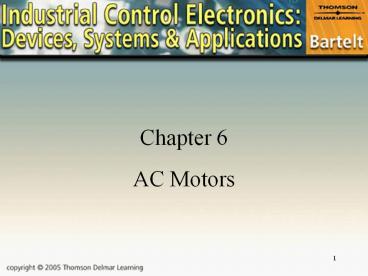Chapter 6 AC Motors * * Fundamental Operation AC Motors - PowerPoint PPT Presentation
1 / 24
Title:
Chapter 6 AC Motors * * Fundamental Operation AC Motors
Description:
Chapter 6 AC Motors * * Fundamental Operation AC Motors convert AC energy into mechanical energy Typical components include Stator (field pole winding) Rotor * Stator ... – PowerPoint PPT presentation
Number of Views:1862
Avg rating:3.0/5.0
Title: Chapter 6 AC Motors * * Fundamental Operation AC Motors
1
Chapter 6
- AC Motors
2
Fundamental Operation
- AC Motors convert AC energy into mechanical
energy - Typical components include
- Stator (field pole winding)
- Rotor
3
Stator/Rotor Action
- The diagram to the right demonstrates one
complete AC cycle being applied to the windings
of an AC motor
4
Stator Construction
- Two-phase operation is necessary to create the
magnetic field conditions needed to generate
torque in an AC motor - Phase 1 is applied to the vertical stator
windings - Phase 2 is applied to the horizontal stator
windings
5
Three-Phase
- Three-phase power is commonly used in industrial
factories - Three-phase power is ideal for powering rotating
stator fields in motors
6
RotorConstruction
- AC motors use electromagnets for their rotors
- Two methods are used for energizing the rotor
- Connect an electrical current to the windings
- Use induction as the means of producing magnetic
fields
7
Types of Rotors
- Squirrel Cage - cage is made of aluminum or
brass, connected to end rings - Wound Rotors - rotor is wound with coils of wire.
The number of coils must be equal to the number
of stator coils
8
Principles of Operation
- The stator winding, when energized, produces a
rotating magnetic field that causes the motor to
turn at synchronous speed - However, the rotor will never catch up to the
stator field - Speed - determined by frequency of the applied
voltage and number of stator poles per phase
9
Speed and Slip
- Speed of a motor is determined by the following
formula - N RPM
- P Number of pole pairs
- f Applied frequency
- 60 Formula constant based upon seconds/minute
10
AC Motor Synchronous Speeds
11
Single-Phase Induction Motors
- Single-phase commercial power is typically
supplied to residential customers - AC induction motors require two phases
- Single-phase AC motors are classified by the
means of obtaining the two phases - Resistance-start, induction-run
- Capacitor-start, induction-run
- Shaded-pole motor
12
Resistance-Start Induction-Run Motor
- Has two separate windings connected in parallel
- Main (run) winding
- Auxiliary (start) winding
- Start winding has high resistance
13
Capacitor-Start Induction-Run Motor
- Two windings, a start and a run winding
- Capacitor is placed in series with the start
winding to obtain higher starting torque - At 70-80 of full speed, capacitor is
disconnected by a centrifugal switch
14
Shaded-Pole Motor
- Uses a squirrel cage rotor and a main winding
- Uses shaded poles to develop rotating field
- Shaded-pole motors are useful in light load
applications
15
Troubleshooting Split-phase Motors
- The most frequent cause of failure in
capacitor-start motors is a defective capacitor - Resistance-start motors usually fail as a result
of a defective centrifugal switch or open start
winding
16
Universal Motors
- Usually classed as an AC motor, but can operate
on DC voltages as well - Similar to a DC series-wound motor
- Universal motors use a laminated iron core versus
the solid iron cores of DC motors - Output torque is less compared to a DC motor
17
Three-Phase Motors
- Most industrial motors operate on three-phase
power - Also referred to as polyphase motors
- Simpler in construction and more powerful than
single-phase motors - Three types
- Induction motor
- Wound-rotor motor
- Synchronous motor
18
Induction Motor
- Most industrial machines are powered by
three-phase squirrel cage induction motors - Small size, efficiency, relatively low-cost
19
Rotating Field
20
Wound-Rotor Motor
- Rotor consists of a set of three coils in place
of conducting bars found in squirrel cage motors - Wound-rotor motors are used where speed and
torque need to be adjustable
21
Synchronous Motor
- Synchronous motors turn at the same speed as the
stators magnetic field - Synchronous motors perform two functions
- Convert electrical energy into mechanical energy
- Perform power factor correction
22
Synchronous Motor Construction and Operation
- The most common type of synchronous motor has two
different rotor circuits - Damper or amortisseur winding
- Squirrel cage bars
- Damper windings are locked on the outer periphery
of the pole core on pole face - The other circuit coils are wound on laminated
core bodies called salient poles
23
Synchronous Operation
- Sometimes, pony motors are used to help get the
synchronous motor up to speed - Once up to speed, the pony motor becomes a DC
generator to provide the excitation current for
the salient poles - The DC generator may be referred to as an exciter
24
Power Factor Correction
- Synchronous motors are often used for power
factor correction in industrial settings - Power factor correction is necessary because
- Current-carrying capabilities of power systems
are reduced - Power companies assess penalties to industrial
users whose power factor is below a specified
level































